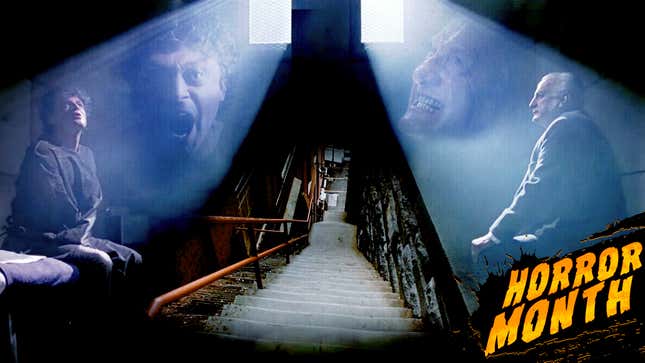
Sequels to The Exorcist always feel sacrilegious, and not necessarily in a good way. How does one follow the scariest movie ever made? It’s a question surely on David Gordon Green’s mind as he releases The Exorcist: Believer, the director’s latest legacy sequel, which—like his Halloween trilogy—skips previous franchise entries and is a direct continuation of the 1973 Oscar-winner. It’s a worthwhile endeavor if not for one problem: The Exorcist III exists. Directed by Exorcist author and screenwriter William Peter Blatty, 1990’s Exorcist III ignores The Exorcist II: The Heretic and presents a direct follow-up to the original. In some ways, it resembles a legacy sequel, but in others, it’s more than happy to go in weirder directions. The movie is a fascinating, imperfect thriller and an unsung victory in the series’ spotty record.
The Exorcist skipped the horror sequel boom of the 1980s with good reason. Echoing the thoughts of many disappointed critics and moviegoers, Exorcist director William Friedkin proclaimed 1977’s The Exorcist II: The Heretic “the worst piece of shit I’ve ever seen.” So, while The Omen’s two sequels followed Damien’s journey to the White House, the Exorcist franchise laid dormant until 1990, when Blatty returned to Washington, D.C. for another possession. Except he didn’t.
An Exorcist sequel without an exorcism?
Based on Blatty’s 1983 novel, Legion, The Exorcist III eschews much of what made Friedkin’s shocker successful. George C. Scott takes over for the late Lee J. Cobb as the movie-loving Washington, D.C., investigator Lieutenant Kinderman. Still haunted by the narrow steps where he found a dead Father Karras (Jason Miller) 15 years earlier, Kinderman sees the inexplicable terror of that night externalized throughout the city as he tries to rationalize a slew of grotesque, faith-based murders committed by the Gemini Killer (Brad Dourif), who had been put to death a decade prior.
Eagle-eyed readers might notice a lack of exorcism in Exorcist III. For much of the movie, the titular practice doesn’t factor in. Kinderman predicts Morgan Freeman’s Detective Somerset from Seven, a rational, learned observer of the world’s descent into damnation. Like Somerset, Kinderman fights on despite his belief in “slime and stink and every crawling, putrid thing,” choosing to ignore the bad if it means protecting the good. Blatty’s focus on Kinderman gives him a new way into the story, foregrounding older people’s perspectives and fears—a shift from the child-focused original. Scott projects a world-weary cynicism crafted through experience and disappointment in what post-Vietnam America has wrought: senseless violence, crumbling institutions, and a profound inkling that the worst is yet to come.
Blatty avoids comparisons to The Exorcist through a gloomy visual language more nightmarish than Friedkin’s grounded, documentary-inspired style. There’s a classical charm to Blatty’s patient camera. It creeps toward D.C.’s gothic churches and urban rot, shoving the viewer into the otherworldly horrors of mundane spaces and a surreal afterlife staged in Grand Central Station and populated by Fabio, a pre-fame Samuel L. Jackson, and the Angel of Death played by Patrick Ewing. But the movie’s centerpiece, a minute-long static shot of a hospital corridor, is pure cinema. Blatty’s lens holds on a nurse doing her evening rounds as the inevitable catches up with her, testing the viewer’s patience and stomach in a tense staredown with the unseen evil onscreen. It’s these simple but effective scares the movie loses in its bombastic, baffling conclusion.
Studio interference sends a promising film to hell
Unconcerned with the preceding movie, the film’s final 15 minutes created problems onscreen and off. Four months after filming wrapped, Blatty, who begged Morgan Creek to drop Exorcist from the title, lost his holy war, leading to studio-mandated reshoots that set the stage for a deus exorcism machina. The finale is an inscrutable but exciting set piece, filled with spectacular effects—cobbled together during the last-minute production—and an unforgettable Brad Dourif dripping with malice and hatred. However, the movie crosses into complete confusion through a tacked-on subplot about Father Morning (Nicol Williamson), a Georgetown exorcist who curiously resembles Max von Sydow’s Father Merrin from the original film. Plus, the Gemini Killer keeps swapping bodies with the late Father Karras (Remember? From the first movie!). None of it makes much sense, but we’ll be damned if a crucified and monologuing George C. Scott isn’t entertaining as hell.
That Blatty wanted to distance himself from exorcisms is understandable. Why remind audiences of the series’ last disappointment? It didn’t help that Leslie Nielsen and Linda Blair’s spoof, Repossessed, was promoted alongside—and opened a month after—Blatty’s film or that Exorcist III was one of six horror sequels between 1989 and 1991. Despite opening at number one, the movie quickly sank like a stone and closed The Exorcist business for another 15 years (only for it to reopen and close again for another 15). Though Exorcist III received some positive reviews, the film’s loudest champion was Jeffrey Dahmer, who watched the film obsessively as one of the real-life killer’s escapees reported.
Over the years, Exorcist III’s reputation as a fan curio, akin to fellow disregarded sequels Psycho II and Halloween III, would grow. In 2016, a long-rumored director’s cut of unfinished footage, rehearsal tapes, and deleted scenes gave us a glimpse of what Blatty originally had in mind. But a reconstructed Legion only reinforces what Exorcist III already proved: Not every Exorcist sequel is an affront to God.